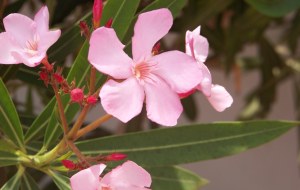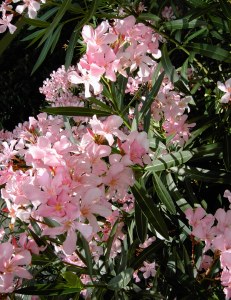





Botanical Name: Nerium oleander
Oleander plant is an easy-to-grow flowering shrub. That is, if you can meet its need for sunshine.

Oleander bush has dark-green, narrow leaves that cover its woody branches.
Clusters of flat-petaled flowers grow at the tips of the stems and are about 2 in (5 cm) wide.
Oleander is a member of the periwinkle family, and the flowers look similar.
They're typically pink, but you may also find oleander flowers in red, white, yellow, coral and salmon. They may be single- or double-flowered. Many varieties are intoxicatingly fragrant.
Prune your plant. Pruning oleander will force the stems to branch out, giving you a much more rounded and attractive plant. Don't be afraid to prune large plants back hard in fall, after flowering.
Yearly pruning will promote vigorous new growth as well as the overall health of your plant. Oleander produces flowers at the end of new stem tips, so you'll get more flowers, too.
Oleander pruning tip: Cut the stem at a 45° angle, 1/4-inch above a leaf node
(the place where a leaf or branch is attached to the stem). Use clean,
sharp pruners
to avoid tearing the woody stems.
Overwintering oleander indoors will protect this frost-tender shrub. If you keep your plant outdoors for the summer, bring it back inside when the temperature drops to 55°F/13°C at night. Some varieties are hardier than others, but they generally don't like the cold at all.
Repot in spring when the roots are growing through the drainage holes of the pot. This is one plant that doesn't like to be crowded. It's a vigorous grower and grows well in a container.
Two pests bother oleander, aphids and scale. If you move your potted oleander outdoors for any length of time, watch for these pests on the stems and undersides of the leaves. Treat any infestation immediately.
All parts of this plant are poisonous. Don't grow this plant indoors if there are children or pets around. Oleander poisoning can cause serious illness or death.

Origin: Mediterranean
Height: Up to 6 ft (1.8 m)
Light: Bright light with at least 4 hours of direct sun each day.
Water: Water generously throughout the growing season, keeping the soil evenly moist. Water sparingly in winter when plant is resting.
Humidity: Average room humidity.
Temperature: Warm 70-85°F, 21-29°C during active growth; cooler in winter at 55°/13°C
Soil: 8 parts all-purpose potting mix, 1 part sand, 1 part perlite
Fertilizer: Feed every 2 weeks spring and summer with a balanced liquid fertilizer diluted by half.
Propagation: Oleander plant is easy to propagate from cuttings. Take 4-in (10 cm) stem tip cuttings in early summer, remove lower leaves. Dip cut end in rooting hormone for best results, then insert in moist potting mix. Keep it in bright light. It will start to grow roots in about 2 weeks.
Copyright © www.100flowers.win Botanic Garden All Rights Reserved